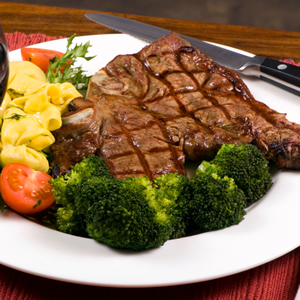First it was no food, and then no fat, and now it’s no carbs. As you tell friends about your new diet, you’re warned—no, almost threatened, with a list of ailments: an inability to think, bad breath, clogged arteries, obesity, and cancer. Finally, your nutritionist strikes the deathblow: your body needs carbohydrates to live.
How, though, can all this be true when studies confirm the opposite? You’ve never heard of anyone dying from not eating carbohydrates, and you’ve seen people have success this way. Still, however, nobody really knows enough yet about these diets, right?
* * *
The low-carb—or ketogenic—diet is nothing new. Its long and storied history began with a small publication written by a guy named William Banting, in 1863. Dr. Atkins, whose first book, Dr. Atkins’ Diet Revolution, wasn’t published until over a hundred years later in 1972, was beaten to the punch by two other versions of the low-carb diet—two of which made it to publication in the late 1950s and early 1960s. Another version had appeared in the 1920s, designed to fight childhood epilepsy, and its use continues today.
While he wasn’t exactly a pioneer, Dr. Atkins managed to popularize the low-carb approach by allowing users to continually increase their dietary carbohydrate levels. This simple change, as opposed to the strict lifetime limits associated with earlier versions, made his low-carb diets highly marketable, but very risky.
To avoid confusion, we need to identify a clear difference among these ketogenic diets, and to also find a more useful term than ketogenic. Mainstream low-carb dieters restrict carbs to 50 percent or less of daily calories, hovering regularly near the top of the scale. Advocates don’t typically explain it this way, but this appears to be the common thread. Scientific research, however, describes a more specific range: 8-50 percent of calories from carbs. This is about 40-250 grams per day. Anything less than 8 percent—30 grams or less—falls under the heading of ultra-low carb. Since these are both ketogenic diets, it may seem like we’re splitting hairs, but the difference between the two is the difference between success and failure.
When you’re on an ultra-low carb diet, your body stops making some very special and bothersome enzymes. These enzymes convert carbohydrates into fat, which can then be stored as body fat. Ultra-low carb diets cut off the one available avenue through which carbohydrates can become body fat, guaranteeing that an overdose of carbs has no possible way of heading to your stomach or thighs in the form of body fat. In contrast, with their extra carb allowance, simple low-carb diets trigger the production of these carb-to-fat converting enzymes, making it possible to store all those extra carbs you thought you were freely enjoying as fat.
 Atkins begins as an ultra-low carb diet for two weeks, after which you slowly switch to the standard low-carb diet by adding fruits, vegetables, and loads of sugar alcohols. Had Dr. Atkins required maintaining the ultra-low portion for the next six months, you’d enjoy ongoing and significant fat loss, even though the rate of fat loss would slow—and eventually plateau. Instead, as carbs increase in your diet, so does body weight. As a matter of fact, by the end of the six months, you’ve stopped losing body fat and started gaining it. For us, for our goal of fat loss, this is the most important difference between low-carb and ultra-low carb diet plans.
Atkins begins as an ultra-low carb diet for two weeks, after which you slowly switch to the standard low-carb diet by adding fruits, vegetables, and loads of sugar alcohols. Had Dr. Atkins required maintaining the ultra-low portion for the next six months, you’d enjoy ongoing and significant fat loss, even though the rate of fat loss would slow—and eventually plateau. Instead, as carbs increase in your diet, so does body weight. As a matter of fact, by the end of the six months, you’ve stopped losing body fat and started gaining it. For us, for our goal of fat loss, this is the most important difference between low-carb and ultra-low carb diet plans.
The simple act of eating carbohydrates, even as little as 50 grams per day, prematurely stops fat loss and can accelerate body fat gain. Avoiding these problems requires 30 grams or less. Does adding more and more carbohydrates, a la Dr. Atkins, make any sense?
We can’t, however, ignore one common fault. Neither diet spikes insulin levels. This is incredibly important. Your body produces the hormone insulin in response to carb-rich meals. Insulin then helps the body use carbohydrates for energy. Since both diets limit the intake of carbs, both also limit the release of insulin. Low-carb enthusiasts flaunt this as an advantage, since elevated levels of insulin often mean little fat burning takes place. An insulin spike, however, only temporarily stops fat burning, but the resultant hormonal afterglow accelerates the process for days.
Besides enhancing metabolism by itself, insulin also creates a lasting glow by acting in a way that’s similar to a booster rocket. Booster rockets provide a short burst of extra force to propel a thing—an airplane, satellite or Space Shuttle—before being ejected. In much the same way, a short and powerful burst of insulin boosts levels of several impressive fat burning hormones. Insulin levels plummet within two hours, but just as the Space Shuttle continues on without its booster rockets, the levels of these fat burning hormones stay elevated for nearly four days. Also like the Space Shuttle, which could never get off the ground without its booster rockets, these crucial hormones will never accelerate fat burning without an insulin spike.
* * *
Of the several hormones affected by insulin spikes, leptin may be the most important. Leptin telegraphs information about body fat reserves and calorie intake throughout your body, acting like a fatness and nutrient thermostat. Normally, when fat cells are full and our bodies get enough food, leptin levels are high. As a result, we can lose body fat. If fat cells empty or calories fall too low, however, leptin levels also fall. Additionally, research shows that stripping carbs from your diet causes leptin levels to plunge no matter how much fat and protein you eat.
Leptin levels mimic the lows found in starvation when carbs are lacking. Low leptin levels signal fat cells to stay full and store as much incoming fat as possible. In other words, kiss your fat loss goodbye. This may explain why several years of maintaining low insulin levels causes unavoidable fat gain—even for people eating only carbs causing small amounts of insulin release. Fat loss and weight maintenance are practically hopeless causes without periodic insulin spikes. Unfortunately, as neither the ultra-low carb nor low-carb diet offers any hope of spiking insulin levels, there appears no way to overcome this fatal deficiency while adhering to the requirements of these diets.
Dr. Atkins claimed that his low-carb diets created a metabolic advantage. What do you think?








Recent Comments